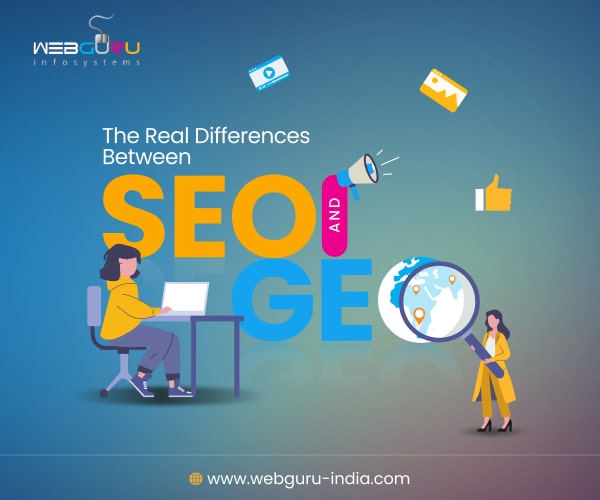Home Blog SEO Services SEO vs. GEO: What’s the Difference and Why You Should Care
SEO vs. GEO: What’s the Difference and Why You Should Care
- 19 May / 2025
- 2,688 views
- 8 Min Read

SEO services have advanced—modern SEO services use both traditional SEO and GEO to increase online visibility. While SEO helps your website rank higher on search engines, GEO ensures your content appears in AI-generated answers, such as those from ChatGPT or a Google search overview. Incorporating both methods can help your brand to reach users on search engines as well as AI platforms. It’s no longer a question of either/or—it’s about creatively utilizing both.
The digital world is throwing a lot of terms at businesses. SEO and GEO are two of the loudest. Many people mix them up, but they are very different from each other. Decoding them can help brands thrive or disappear online.
Many people already know about SEO services, and GEO (Generative Engine Optimization) often hides in the shadows. Search engine optimization definitely helps brands climb the SERP ladder, but effective GEO strategies can add an extra twist. So, let’s learn how they work together and apart to make your online success.
What Exactly Are SEO and GEO?
SEO focuses on making websites rank higher on search engines. On the other hand, the GEO process helps a website’s content to get better visibility in AI-driven search engines. Both of the things help brands connect with audiences, but they do it in unique ways.
Search Engine Optimization (SEO) is a set of practices used to enhance a website’s visibility on search engine results pages. The main aim revolves around ranking higher when potential customers are searching for similar keywords. SEO involves many techniques, such as keyword optimization, content generation, backlinking, and technical site enhancements.
Generative Engine Optimization (GEO) targets the optimization of your content on your site to increase your site’s exposure in AI search engines like ChatGPT, Perplexity, Gemini, Copilot, and Google AI Overviews. This new approach makes your company visible in AI-generated results if users search using queries related to your services, products, or areas of competence.
Now, it can be said that SEO is effective but not enough! GEO should be in the strategy, especially when AI-generated overviews now appear in up to 47% of Google searches. On mobile devices, AI overviews can cover up to 75.7% of the screen. So, now businesses need to play more strategically and smarter, and there’s no way to ignore AI anymore!
Key Differences Between SEO and GEO You Should Be Aware Of
Both SEO and GEO aim to increase content visibility. However, there are key differences between them in terms of the targeted platforms and overall user experience. Let’s explore the critical differences first and then how we can align both worlds for better results.
The Work Approach
The search engine optimization happens through a three-stage process. The first stage is crawling, where search engines deploy bots to find content by following links across the web. In the next indexing phase, discovered content is processed and then stored in a massive database. When a user conducts any search, the search engine retrieves relevant data/content and ranks it based on factors like
- Keyword relevance and placement
- Backlink quality and quantity
- User experience signals
- Content quality and comprehensiveness
- Technical factors like loading speed, responsiveness, security, etc.
GEO boosts your content’s visibility in AI-powered platforms like ChatGPT or Google Search AI overviews. Here’s the process:
- Content ingestion starts as AI systems ingest web information via pre-training or real-time pulling.
- Knowledge extraction comes next when AI recognizes significant facts and relationships in your content.
- When users ask questions, relevance evaluation decides what sources have the most credible information.
- Response generation finishes the task since AI creates answers by combining information, possibly referencing your content if it gives concise facts, organized information, original insights, and proof of expertise.
The fundamental difference is SEO needs to rely on ranking signals to determine your content’s position in the list. But GEO relies on information quality and structure to determine inclusion in synthesized answers.
Also Read: How AI is Affecting SEO? Things You Need to Know
Content Display
SEO results show web pages in order of relevance and page quality to the search engine query. Users view a list of links, each with a short description, in order of perceived relevance. Your content is one of many possibilities that appear.
GEO returns real-time generated AI answers summarizing data from various sources. Rather than links to click on, people are given synthesized answers from several websites, along with citations of the original source. Your content might become part of a larger narrative rather than a standalone destination.
This basic difference in presentation alters the way contemporary users interact with and view sources of information. The classic “ten blue links” in the SERP is starkly different from AI’s conversational, synthesized answers.
User Interaction
SEO involves users clicking on single links to visit relevant web pages. The user process entails checking search results, choosing promising options, visiting websites, and perhaps going back to search results if the information is not adequate. This process requires more active selection from users.
GEO makes it possible for users to get answers with sources, cutting down on the number of clicks and effort involved. Much of the information gathering and synthesis is taken care of by the AI platform, giving users complete answers that may render a visit to specific websites unnecessary. This streamlined experience changes user expectations.
Content Structure
SEO content is keyword-optimized for particular words, with technical and on-page SEO in consideration. Content structure usually adheres to known patterns that search engines understand—headings, subheadings, keyword density, meta descriptions, alt tags, and other old-school optimization features. The focus remains on signaling relevance to search algorithms.
GEO delivers users authoritative content extracted from various sources, formatted to provide explicit answers to particular user questions. Content needs to prove expertise, accuracy, and comprehensiveness worthy of a citation by AI systems. The emphasis shifts from keyword optimization to becoming the most authoritative voice on a topic.
Performance Metrics
SEO performance is measured by traffic and conversion metrics. Indicators of success are keyword rankings, volume of organic traffic, click-through rates, bounce rates, time on page, and conversion rates from organic search visitors. These are indicators of how well your content is attracting and engaging website visitors.
GEO tracks outcomes based on how frequently your content is referenced or cited by AI-returned results. Important metrics involve frequency of citations, visibility in AI responses, attribution rates, traffic from referrals by AI platforms, and visitor engagement metrics coming from visitors by way of AI citations. These newer metrics require different tracking and analysis methods.
A Quick Comparison Table— SEO Vs. GEO
| Comparison Factor | Traditional SEO | Generative Engine Optimization (GEO) |
| Primary Goal | Achieve high rankings in search result pages | Secure mentions in AI-generated responses |
| Discovery Process | Bot crawling → Database indexing → Algorithm ranking | Content absorption → Knowledge structuring → Relevance matching → Answer synthesis |
| User Experience | Users scan results, click links, and browse websites | Users receive comprehensive answers without leaving the AI interface |
| Content Requirements | Keyword-optimized, technically sound, backlink-supported | Factually accurate, clearly structured, authoritative, directly answering common questions |
| Success Indicators | Position in search rankings, organic traffic volume, click-through rates | Citation frequency in AI responses, attribution quality, referred traffic from AI platforms |
| User Interaction Model | Multiple clicks across different information sources | Conversation with AI that synthesizes multiple sources |
| Information Presentation | Separate websites competing for attention | Integrated information from multiple sources in one response |
| Visibility Format | Website link with meta description | Direct content quotation or citation within answers |
| Technical Focus | Site speed, mobile optimization, structured data markup | Clear factual statements, organized information hierarchies, authoritative positioning |
| Traffic Source | Direct website visits | Citations and references in AI responses |
| Algorithm Updates | Periodic search engine algorithm changes (months/years) | Continuous AI model improvements and training updates |
| Content Structure Priority | Headers, keywords, meta elements, internal linking | Clear factual statements, comprehensive topic coverage, demonstrable expertise |
| Competitive Dynamic | Outranking other websites for valuable keywords | Becoming the preferred citation source for AI responses |
| Platform Examples | Google Search, Bing, Yahoo | ChatGPT, Google AI Overviews, Perplexity, Gemini |
How Can You Combine SEO and GEO in Your Strategy?
Though they are distinct, GEO and SEO are complementary methods and not opposing strategies. Smart marketers should appreciate the synergy between these approaches and apply them in conjunction. The foundation always relies on quality content that serves both purposes simultaneously.
Detailed content forms the foundation for both strategies. In-depth, authoritative content ranks well in traditional search results and gives AI systems extraction-worthy content. The E-E-A-T guidelines (expertise, experience, authoritativeness, and trustworthiness) equally favor both traditional rankings and AI citations.
Strategic content structure boosts both optimization methods. Definite, descriptive headings enhance SEO readability and become ideal extraction points for AI systems. FAQ blocks meet featured snippet potential and serve direct answers that AI can reference in responses. Structured data markup increases SEO in the form of rich results while enabling data to be more parsable for AI systems.
The best digital strategy combines both methods to build a complete presence on all channels of information retrieval so that it is seen no matter how users query. Users ask questions; relevance assessment decides which sources provide the most trustworthy information. Response generation caps it off as AI generates responses, possibly referencing your content if it presents definitive facts, organized information, novel insights, and demonstrated expertise.
Also Read: Want More Traffic? Try These 10 Quick SEO Tips for Faster Ranking Gains
Conclusion
Knowing the differences between SEO and GEO gives businesses better ways to boost their digital presence across the entire search ecosystem. The distinctions matter because they determine how potential customers discover and interact with companies online. While SEO is about familiar search engines, GEO is about the nascent ecosystem of AI-driven search results.
Digital companies don’t have to pick between these strategies but rather use them strategically in combination. The complementary nature of the strategies can create synergistic effects that neither strategy achieves independently. Users can benefit from finding relevant information regardless of their preferred search method, while businesses enjoy more qualified leads and higher conversion rates.
FAQs
1. What’s the difference between SEO and GEO?
GEO and SEO are two different methods of search optimization. SEO is about increasing website presence in traditional search engine results, while GEO is all about optimizing AI-generated answers and generative search engines. SEO relies on keywords and backlinks, while GEO is based on structured data and AI-optimizable content structures.
2. Can GEO replace SEO?
No, GEO is not a substitute for SEO but a complementary approach. While SEO is still essential for search visibility, GEO is gaining prominence for AI-powered searches. Optimizing website content for both SEO and GEO is essential for greater visibility and organic traffic from diverse sources.
3. What are the benefits of implementing GEO?
Using GEO for your content enhances visibility in voice search results and AI-generated answers, providing a better user experience through direct answers.Optimizing for GEO can also future-proof your content strategy and make it more responsive to new search technologies. Optimizing for both traditional and AI-powered searches helps businesses to reach more people and stay relevant in an increasingly AI-saturated digital landscape.

Sujata Bhattacharjee
Sujata Bhattacharjee is a versatile content writer with a passion for crafting engaging narratives. Her work blends creativity with expertise, captivating readers across diverse topics effortlessly.

-
1000+
Happy
Clients -
25+
Countries
Served -
19+
Years of
Trust







